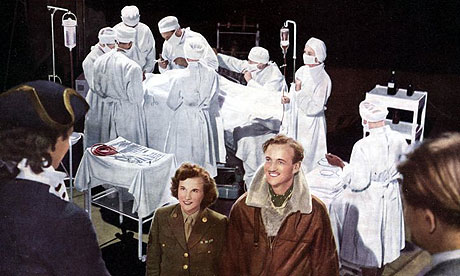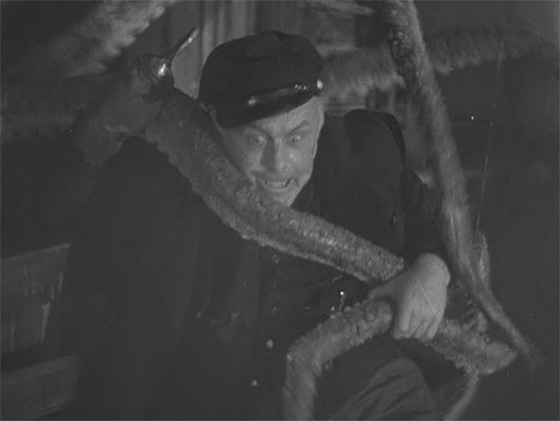A Guide to the Interesting and Unusual on TCM
By Ed Garea
July 2
10:15 am A Matter of Life and
Death (The Archers/Universal,
1946) – Director: Michael Powell & Emeric Pressburger. Cast: David Niven,
Kim Hunter, Robert Coote, Kathleen Byron, & Richard
Attenborough. Color, 104 minutes.
The ‘40s were an extraordinarily fruitful time for the duo of Powell
and Pressburger. Besides this film, they co-wrote, co-produced and co-directed
such well-known classics as The Life and Death of Colonel Blimp (1943),
A Canterbury Tale (1944), ‘I Know Where I’m Going!’ (1945), Black
Narcissus (1947), and The Red Shoes (1948). It’s
quite a track record, to say the least. Given that roster, it would be
difficult to say for sure which was the best of the lot; it all comes down to
personal favorites. My personal favorite of the bunch is A Canterbury
Tale, but many more film buffs, I’m sure, would rate this film as their
favorite. The plot, about a RAF flyer who falls in love and dies before his
time, then asks Heaven to decide whether or not he deserves a second chance, is
beautifully written, directed, and acted (including a near-perfect performance
by the then unknown Hunter). If you’re one of the few that hasn’t yet seen it –
and, believe me, you’re in a distinct minority – then I wholeheartedly
recommend you get up to speed, so to speak. You will not be disappointed, for
the film holds up as well today as it did when it was released.
Trivia: The film was released as Stairway to Heaven in
the United States.
8:00 pm In Our Time (WB, 1944) – Director: Vincent Sherman. Cast:
Paul Henried, Ida Lupino, Nancy Coleman, Mary Boland, & Alla Nazimova.
B&W, 109 minutes.
Warner Brothers gives us this offbeat (in terms of subject matter)
film set in pre-war Poland right before the Nazi invasion. Dashing Henried is a
Polish count and Lupino his English-born wife. Leonard Maltin calls it “a plush
soaper,” and noted that it “never quite hits the mark.” I have to agree with
Maltin here, but I recommend this nonetheless because of the subject matter and
the performance of Nazimova, who steals the film as Henreid’s aristocratic
mother.
Trivia: When director Sherman started out as an actor on stage in
1931, he secured a small role in Nazimova’s stage production of The Good
Earth thanks to her good graces. He never forgot, and when Nazimova
was suffering financial and health setbacks, he cast her as Henried’s mother in
the film.
July 5
6:15 am Sh! The Octopus (WB, 1937) – Director: William McGann. Cast:
Hugh Herbert, Allen Jenkins, Marcia Ralston, & John Eldredge. B&W, 60
minutes.
Bad Movie Alert: Usually, Bryan Foy, who headed the Warner
Bros. B-unit, made fast, entertaining films that sometimes outshone the
featured film on the bill. Not this time, though. Herbert and Jenkins are dizzy
detectives trapped in a deserted lighthouse with a group of strangers. Besides
being terrorized by a killer octopus (!), there is also a mysterious crime
figure known as The Octopus. It’s actually based on a Broadway play from 1928
that ran for only 47 performances, though it seems more like a remake of The
Gorilla with The Bat Whispers thrown in for good
measure. If bad movies are your thing, this won’t disappoint, especially when
you get a gander at the visible wires moving the octopus.
8:30 am Thunder Rock (MGM, 1943) – Director: Roy Boulting. Cast:
Michael Redgrave, Barbara Mullen, James Mason, & Lilli Palmer. B&W, 90
minutes.
If Powell and Pressburger could be said to have any competition in
the British film world, it would come from the formidable producer/director
team of brothers John and Roy Boulting. Disillusioned world-renowned journalist
David Charleston (Redgrave) has given up trying to warn Europe of the dangers of
fascism and the coming war so he retires to a life as a lighthouse keeper on
Lake Michigan. Though a series of imaginary conversations with the passengers
on a boat that sank in the 19th century, he begins to recover
his own will to live and fight.
June 6
7:30 am Hercules, Samson and
Ulysses (MGM, 1963) – Director:
Pietro Francisci. Cast: Kirk Morris, Richard Lloyd, Liana Orfel, & Enzo
Cerusico. Color, 85 minutes.
Italian sword and sandal movies are always enjoyable viewing – especially
on a Saturday morning when nothing else is being shown – and this one will fill
any movie lover’s bill. Morris, Lloyd, and Cerusico play the mythic heroes, as
the marooned Hercules and Ulysses team up with Samson to battle sea monsters
and the tyrant of Gaza.
The movie pulls out all the stops as it emphasizes
every cliché of the genre – from fights to the death with lions to a boulder
tossing battle between Hercules and Samson that sets a record for use of
Styrofoam props. Just park the brain for 90 minutes or so and enjoy the fun.
9:30 am Terror of Rome Against
the Son of Hercules (Embassy, 1964) – Director: Mario Caiano. Cast: Mark Forest,
Marilu Tolo, Elisabetta Fanti, Claudio Undari, & Franco Cobianchi. Color, 103 minutes.
Now, if you didn’t get your fill of the genre in the previous
film, TCM brings you yet another. Made in Italy as Maciste, gladiatore di Sparta (Maciste,
Gladiator of Sparta), it was released in the U.S. under the title above. Forest
is Maciste, and the highlight (?) of the movie is where he fights a skinny ape
man in the arena. It’s guaranteed 100% psychotronic.
3:45 am Children of the Damned (MGM, 1964) – Director: Anton M. Leader. Cast:
Ian Hendry, Alan Badel, Barbara Ferris, Alfred Burke, Sheila Allen & Ralph
Michael. B&W, 90 minutes.
MGM British Studios had an unexpected hit in 1960 with Village
of the Damned, where George Sanders sacrifices himself to stop 12 alien
children from taking over the world. This follow-up is taken from the same
source – John Wyndham’s sci-fi novel The Midwich Cuckoos – but
this time there are six children that are discovered by authorities and flown
to London for further study. But if the producers thought they would make an
improvement over Village of the Damned, they were sadly
mistaken. The film lacks the punch and the vigor of the original and
rather cops out in the end. Still, for sci-fi fans and completists, it’s must
viewing.
June 7
9:30 pm The Devil-Doll (MGM, 1936) – Director: Tod Browning. Cast:
Lionel Barrymore, Henry B. Walthall, Maureen O’Sullivan, Frank Lawton, Rafaela
Ottiano, & Robert Grieg. B&W, 79 minutes.
For many critics and historians, the advent of sound was one of
the worst things that happened to Tod Browning – that and the reception of his
movie Freaks, that is. Sound seemed to cramp Browning’s macabre
stylings; the camera became static, as if he were filming a stage play.
(However, when I first saw Freaks, the one thing that stuck out in
my mind was the fluid camerawork.) But this film seemed to have shaken Browning
out of his “doldrums,” as it were.
In The Devil-Doll, the camerawork is masterful, and
the special effects – especially the scenes featuring oversized sets and
“miniature” people still retain their power to dazzle. Barrymore has a field
day as Lavond – a falsely incarcerated businessman who escapes Devil’s Island
with diabolical inventor Marcel (Walthall). Marcel has come up with a formula
for shrinking people to doll-like size, and bequeaths it to Lavond. Lavond uses
it for revenge on those that framed him. Like Browning’s other films, it’s
difficult to classify this in the strict horror genre, but at any rate, it’s
good viewing.
Trivia: Bert I. Gordon remade this in 1958 as Attack of the
Puppet People, starring that noted thespian, John Agar.
2:45 pm La Cucaracha (Azteca, 1959) – Director: Ismael Rodriguez.
Cast: Maria Felix, Emilio Fernandez, Dolores Del Rio, & Pedro Armendariz. Color,
97 minutes.
Mexico's four biggest stars – Felix, Del Rio, Armendariz, and Fernandez
– star in this melodrama of love and passion during the Mexican revolution from
director Rodriguez.
Felix, Mexico's biggest female star at the time, plays Refugio, a
soldier in the Revolution who can shoot, ride, drink, and fight as hard as any
man. She is known among the men in her loosely formed band of warriors as “La
Cucaracha,” because, like a cockroach, she is not satisfied with one mate, Del
Rio, Mexico's other top female star, is Isabel Puente, the wife of the local
teacher and the opposite of Refugio in every way: cultured, refined, and
devoted to only one man.
Isabel and Refugio do not cross paths until Colonel Antonia Zeta
(Fernandez) rides into their village to take charge of the rebels. At first he
becomes involved with Refugio, but comes to the realization that their affair
is destructive when he kills Valentin Razo (Armendariz) purely out of jealousy.
When he ends the relationship and turns his attentions to the quietly beautiful
Isabel (now a widow), his actions stir feelings of anger and resentment in
Refugio.
The performances of the leads and the stunning Eastman Color
photography make La Cucaracha one to watch, especially for
those unfamiliar with Mexican cinema of the ‘50s and early ‘60s. Not all
Mexican movies featured wrestlers fighting monsters, but sadly, those were the
ones most often shown on American television during the ‘60s and ‘70s, when
many of us were in out formative film years.




No comments:
Post a Comment